初三英语语法词性详解-名词 课件(21张PPT)
文档属性
| 名称 | 初三英语语法词性详解-名词 课件(21张PPT) | 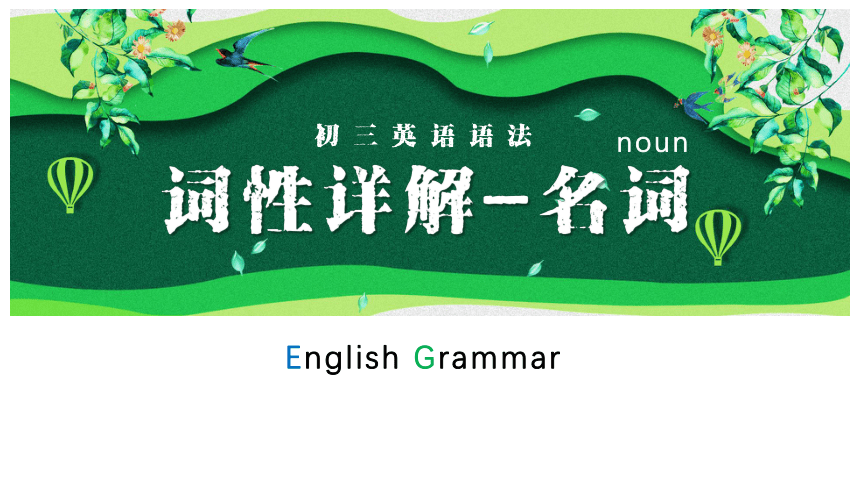 | |
| 格式 | pptx | ||
| 文件大小 | 10.1MB | ||
| 资源类型 | 教案 | ||
| 版本资源 | 通用版 | ||
| 科目 | 英语 | ||
| 更新时间 | 2021-02-12 09:52:18 | ||
图片预览

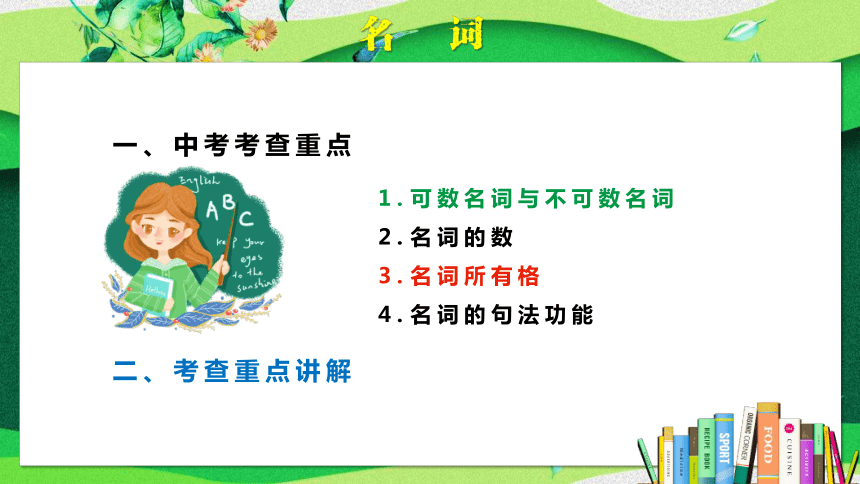
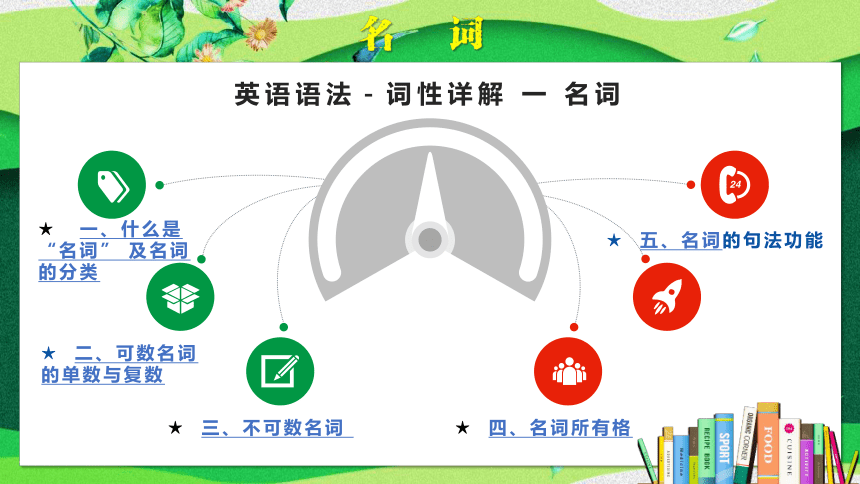
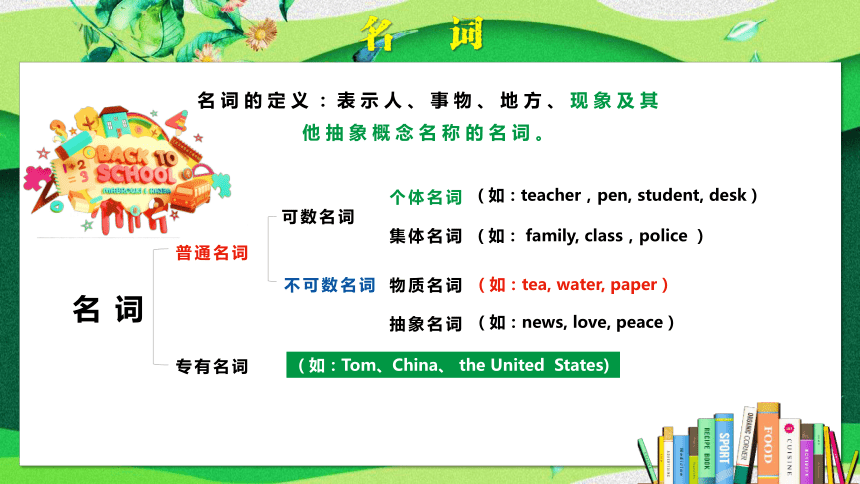
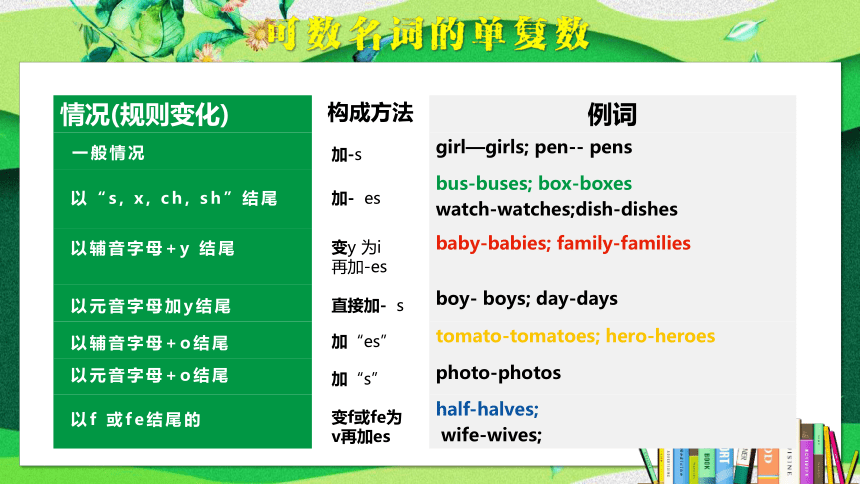
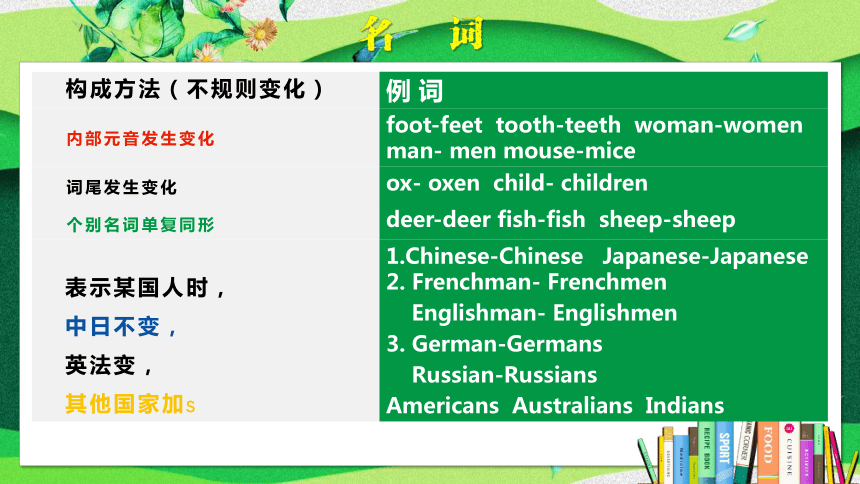
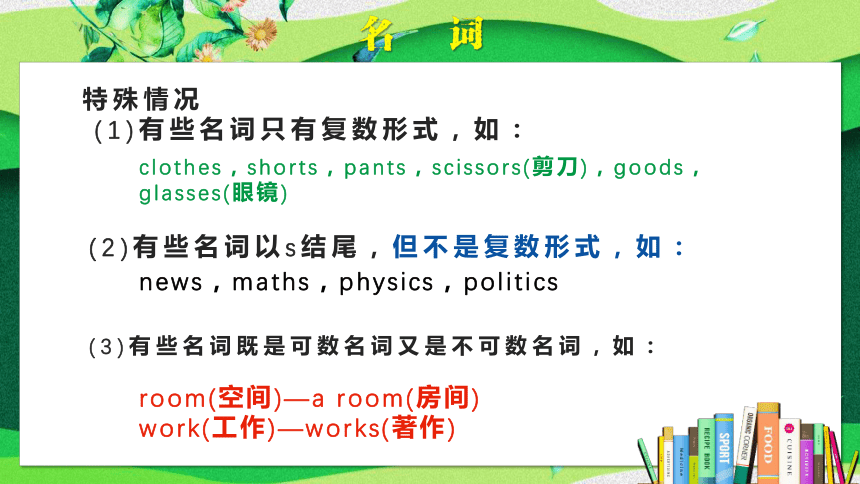
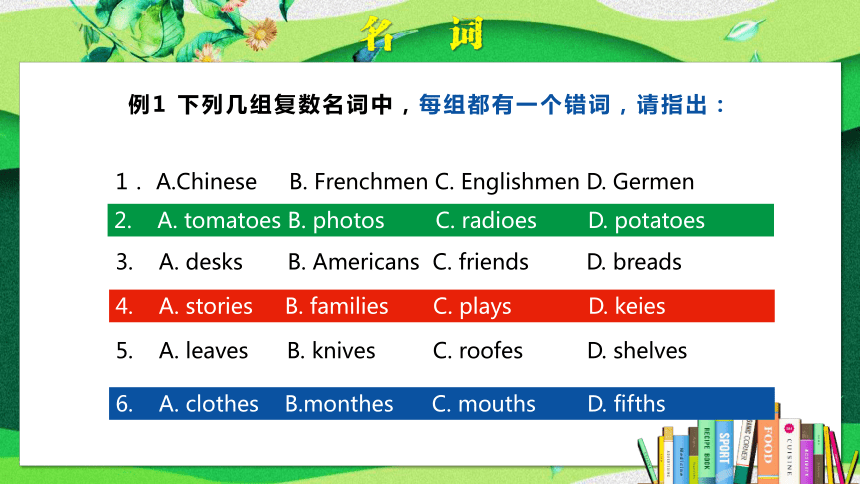
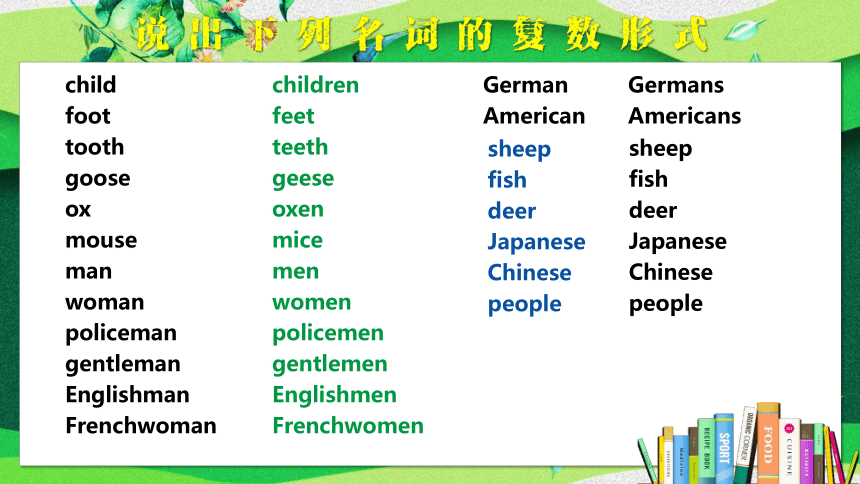
文档简介
词性详解-名词
初三英语语法
noun
English Grammar
一、中考考查重点
二、考查重点讲解
可数名词与不可数名词
名词的数
名词所有格
名词的句法功能
名 词
名 词
英语语法-词性详解 一 名词
★?? 一、什么是“名词” 及名词的分类
★??二、可数名词的单数与复数
★??三、不可数名词
★? 四、名词所有格
★? 五、名词的句法功能
名 词
名 词
可数名词
普通名词
物质名词
抽象名词
个体名词
集体名词
不可数名词
名词的定义:表示人、事物、地方、现象及其他抽象概念名称的名词。
(如:teacher,pen, student, desk)
(如: family, class,police )
(如:tea, water, paper)
(如:news, love, peace)
专有名词
(如:Tom、China、 the United States)
可数名词的单复数
情况(规则变化)
构成方法
例词
girl—girls; pen-- pens
bus-buses; box-boxes
watch-watches;dish-dishes
baby-babies; family-families
boy- boys; day-days
tomato-tomatoes; hero-heroes
photo-photos
half-halves;
wife-wives;
一般情况
以“s, x, ch, sh”结尾
以辅音字母+y 结尾
以辅音字母+o结尾
以f 或fe结尾的
加-s
加- es
加“es”
加“s”
变f或fe为
v再加es
以元音字母+o结尾
变y 为i
再加-es
直接加- s
以元音字母加y结尾
名 词
构成方法(不规则变化)
例 词
foot-feet tooth-teeth woman-women man- men mouse-mice
ox- oxen child- children
deer-deer fish-fish sheep-sheep
1.Chinese-Chinese Japanese-Japanese
2. Frenchman- Frenchmen
Englishman- Englishmen
3. German-Germans
Russian-Russians
Americans Australians Indians
内部元音发生变化
词尾发生变化
个别名词单复同形
表示某国人时,
中日不变,
英法变,
其他国家加s
名 词
特殊情况
(1)有些名词只有复数形式,如:
clothes,shorts,pants,scissors(剪刀),goods,glasses(眼镜)
(2)有些名词以s结尾,但不是复数形式,如:
news,maths,physics,politics
(3)有些名词既是可数名词又是不可数名词,如:
room(空间)—a room(房间)
work(工作)—works(著作)
名 词
例1 下列几组复数名词中,每组都有一个错词,请指出:
1. A.Chinese B. Frenchmen C. Englishmen D. Germen
2. A. tomatoes B. photos C. radioes D. potatoes
3. A. desks B. Americans C. friends D. breads
4. A. stories B. families C. plays D. keies
5. A. leaves B. knives C. roofes D. shelves
6. A. clothes B.monthes C. mouths D. fifths
说出下列名词的复数形式
child
foot
tooth
goose
ox
mouse
man
woman
policeman
gentleman
Englishman
Frenchwoman
sheep
fish
deer
Japanese
Chinese
people
German
American
children
feet
teeth
geese
oxen
mice
men
women
policemen
gentlemen
Englishmen
Frenchwomen
sheep
fish
deer
Japanese
Chinese
people
Germans
Americans
不可数名词
不可数名词:(前面不能用a,an等来修饰)
到目前为止我们所学的不可数名词有:
①液体类:
②肉类:
③粉末类:
④抽象名词类:
⑤食物类:
不可数名词计量的表达:
①个数单位词:piece (张、片、块、条),②容器单位词:bottle(瓶),bag(包),box(盒、箱),
③类别单位词:kind( 种、类) ④度量衡单位词:kilo(千克、公斤)
water:juice,tea , soup ,milk,cola,coffee,
meat,beef, pork, mutton
food, broccoli,? rice, porridge, junk food ,tofu
bread
news,information,money,advice,friendship,work,homework,housework, schoolwork ,help ,fun,health,price
不可数名词
记住: roof – roofs , chef – chefs , chief - chiefs
Exercises:
1.把下面名词变为复数:
City brush
Leaf potato
Tomato bread
Broccoli milk
beef
2. 翻译下面的词组:
1.两杯咖啡
2.四快面包
3. 七袋大米
4. 八只鹿
5.一滴水
6.三个男孩
two cups of coffee
four pieces of bread
seven bags of rice
eight deer
a drop of water
three boys
名词的所有格
双重所有格
单重所有格
of所有格
’s所有格
名词所有格 表示所属关系
名词的所有格
构成方法
例句
Linda’s desk
the boys’ friends
the children’s Day
Lucy and Lily’s mother
Lucy’s and Lily’s books
today’s newspaper
fifteen minutes’ walk
表示时间、距离的名词可以加’s 或’ 构成所有格形式
一般在有生命名词后加? ’ s 构成。
若以S结尾复数名词,则在S后加’?
若不是以S结尾复数名词,则加’s
表示几个人共同的东西,只在最后一个人后加’s.
表示几个人都分别有的东西,则每个都加’s.
表示某人的家、店铺、诊所时,常省略所有格 后面的名词
at my uncle’s
= at my uncle’s home
名词的所有格
2.表示无生命事物的所有关系:
a map of China
the name of the film
the cover of the book
电影的名字
中国地图
书的封面
一般用...of...结构来表示无生命的名词所有格:
2)名词+of+ 名词性物主代词
1)名词+of +名词所有格: a friend of Jack’s
3.名词的双重所有格:就是指同时既使用 -’s 所有格又使用 of 所有格。
a friend of hers
a photo of Mr Smith’s
a photo of Mr Smith
史密斯先生收藏的一张照片
史密斯先生照的一张照片
名词的所有格
名词的所有格
my teacher’s office
students’ exercise books
Children’s Day
today’s newspaper
15 minutes’ walk = a 15-minute walk
to Tom’s = to Tom’s house
1 我老师的办公室
2 学生们 的练习本
3 儿童节
4 今天的报纸
5 十五分钟的路程
6 到汤姆家去
名词的所有格 Practice
名词的所有格
7 广东的省会
8 教室的门
9 我父亲的一个朋友
10 他的两个兄弟
11 爱迪生的一些发明
12 他弟弟的一张照片(照片属于他弟弟)
13 他弟弟的一张照片(照片里的人是他弟弟)
the capital of Guangdong
the doors of the classroom
a friend of my father (’s)
two brothers of his
some inventions of Edison’s
a picture of his brother’s
a picture of his brother
名词的句法功能
1.名词作主语
Physics is a new subject in Grade Two.
My glasses are red.
A new pair of pants is on the bed.
Two pairs of pants are on the bed.
一些以s结尾的名词。如:maths、physics、news是单数或不可数名词,在句中作主语时,谓语动词要用第三人称单数形式;但a (this)pair of+名词复数时,其主语是a(this)pair,故谓语动词应用单数形式。如:
名词的句法功能
(2)表示时间、金钱、距离、价格等名词后加s作主语时,应视为一个整体,故谓语动词用单数形式。如:
Her family is moving to Liaoning next week.
Her family are having supper now.
Twenty dollars is enough. Three months is a short time.
(3)family,class,police等作主语时,若表示整体概念,谓语动词用第三人称单数;当表示其中的各个成员时,谓语动词用复数形式。如:
名词的句法功能
(4)主语后跟with,except,together with,as well as等短语时,谓语动词应与前面的主语保持一致,而不受这些短语的影响。如
Mr Li with his students is discussing the math problem.
All the girls except Mary are drawing in the classroom.
名词的句法功能
2.名词作定语
There is one toy factory in the city.
There are two toy factories in the city.
(1)名词作定语,一般用单数形式。如:
(2)woman, man 做定语修饰名词时,若所修饰的名词是单数,则man 和woman用单数。若所修饰的名词是复数,则man 和woman用复数。如:
There is a woman teacher.
There are three women teachers.
初三英语语法
noun
English Grammar
一、中考考查重点
二、考查重点讲解
可数名词与不可数名词
名词的数
名词所有格
名词的句法功能
名 词
名 词
英语语法-词性详解 一 名词
★?? 一、什么是“名词” 及名词的分类
★??二、可数名词的单数与复数
★??三、不可数名词
★? 四、名词所有格
★? 五、名词的句法功能
名 词
名 词
可数名词
普通名词
物质名词
抽象名词
个体名词
集体名词
不可数名词
名词的定义:表示人、事物、地方、现象及其他抽象概念名称的名词。
(如:teacher,pen, student, desk)
(如: family, class,police )
(如:tea, water, paper)
(如:news, love, peace)
专有名词
(如:Tom、China、 the United States)
可数名词的单复数
情况(规则变化)
构成方法
例词
girl—girls; pen-- pens
bus-buses; box-boxes
watch-watches;dish-dishes
baby-babies; family-families
boy- boys; day-days
tomato-tomatoes; hero-heroes
photo-photos
half-halves;
wife-wives;
一般情况
以“s, x, ch, sh”结尾
以辅音字母+y 结尾
以辅音字母+o结尾
以f 或fe结尾的
加-s
加- es
加“es”
加“s”
变f或fe为
v再加es
以元音字母+o结尾
变y 为i
再加-es
直接加- s
以元音字母加y结尾
名 词
构成方法(不规则变化)
例 词
foot-feet tooth-teeth woman-women man- men mouse-mice
ox- oxen child- children
deer-deer fish-fish sheep-sheep
1.Chinese-Chinese Japanese-Japanese
2. Frenchman- Frenchmen
Englishman- Englishmen
3. German-Germans
Russian-Russians
Americans Australians Indians
内部元音发生变化
词尾发生变化
个别名词单复同形
表示某国人时,
中日不变,
英法变,
其他国家加s
名 词
特殊情况
(1)有些名词只有复数形式,如:
clothes,shorts,pants,scissors(剪刀),goods,glasses(眼镜)
(2)有些名词以s结尾,但不是复数形式,如:
news,maths,physics,politics
(3)有些名词既是可数名词又是不可数名词,如:
room(空间)—a room(房间)
work(工作)—works(著作)
名 词
例1 下列几组复数名词中,每组都有一个错词,请指出:
1. A.Chinese B. Frenchmen C. Englishmen D. Germen
2. A. tomatoes B. photos C. radioes D. potatoes
3. A. desks B. Americans C. friends D. breads
4. A. stories B. families C. plays D. keies
5. A. leaves B. knives C. roofes D. shelves
6. A. clothes B.monthes C. mouths D. fifths
说出下列名词的复数形式
child
foot
tooth
goose
ox
mouse
man
woman
policeman
gentleman
Englishman
Frenchwoman
sheep
fish
deer
Japanese
Chinese
people
German
American
children
feet
teeth
geese
oxen
mice
men
women
policemen
gentlemen
Englishmen
Frenchwomen
sheep
fish
deer
Japanese
Chinese
people
Germans
Americans
不可数名词
不可数名词:(前面不能用a,an等来修饰)
到目前为止我们所学的不可数名词有:
①液体类:
②肉类:
③粉末类:
④抽象名词类:
⑤食物类:
不可数名词计量的表达:
①个数单位词:piece (张、片、块、条),②容器单位词:bottle(瓶),bag(包),box(盒、箱),
③类别单位词:kind( 种、类) ④度量衡单位词:kilo(千克、公斤)
water:juice,tea , soup ,milk,cola,coffee,
meat,beef, pork, mutton
food, broccoli,? rice, porridge, junk food ,tofu
bread
news,information,money,advice,friendship,work,homework,housework, schoolwork ,help ,fun,health,price
不可数名词
记住: roof – roofs , chef – chefs , chief - chiefs
Exercises:
1.把下面名词变为复数:
City brush
Leaf potato
Tomato bread
Broccoli milk
beef
2. 翻译下面的词组:
1.两杯咖啡
2.四快面包
3. 七袋大米
4. 八只鹿
5.一滴水
6.三个男孩
two cups of coffee
four pieces of bread
seven bags of rice
eight deer
a drop of water
three boys
名词的所有格
双重所有格
单重所有格
of所有格
’s所有格
名词所有格 表示所属关系
名词的所有格
构成方法
例句
Linda’s desk
the boys’ friends
the children’s Day
Lucy and Lily’s mother
Lucy’s and Lily’s books
today’s newspaper
fifteen minutes’ walk
表示时间、距离的名词可以加’s 或’ 构成所有格形式
一般在有生命名词后加? ’ s 构成。
若以S结尾复数名词,则在S后加’?
若不是以S结尾复数名词,则加’s
表示几个人共同的东西,只在最后一个人后加’s.
表示几个人都分别有的东西,则每个都加’s.
表示某人的家、店铺、诊所时,常省略所有格 后面的名词
at my uncle’s
= at my uncle’s home
名词的所有格
2.表示无生命事物的所有关系:
a map of China
the name of the film
the cover of the book
电影的名字
中国地图
书的封面
一般用...of...结构来表示无生命的名词所有格:
2)名词+of+ 名词性物主代词
1)名词+of +名词所有格: a friend of Jack’s
3.名词的双重所有格:就是指同时既使用 -’s 所有格又使用 of 所有格。
a friend of hers
a photo of Mr Smith’s
a photo of Mr Smith
史密斯先生收藏的一张照片
史密斯先生照的一张照片
名词的所有格
名词的所有格
my teacher’s office
students’ exercise books
Children’s Day
today’s newspaper
15 minutes’ walk = a 15-minute walk
to Tom’s = to Tom’s house
1 我老师的办公室
2 学生们 的练习本
3 儿童节
4 今天的报纸
5 十五分钟的路程
6 到汤姆家去
名词的所有格 Practice
名词的所有格
7 广东的省会
8 教室的门
9 我父亲的一个朋友
10 他的两个兄弟
11 爱迪生的一些发明
12 他弟弟的一张照片(照片属于他弟弟)
13 他弟弟的一张照片(照片里的人是他弟弟)
the capital of Guangdong
the doors of the classroom
a friend of my father (’s)
two brothers of his
some inventions of Edison’s
a picture of his brother’s
a picture of his brother
名词的句法功能
1.名词作主语
Physics is a new subject in Grade Two.
My glasses are red.
A new pair of pants is on the bed.
Two pairs of pants are on the bed.
一些以s结尾的名词。如:maths、physics、news是单数或不可数名词,在句中作主语时,谓语动词要用第三人称单数形式;但a (this)pair of+名词复数时,其主语是a(this)pair,故谓语动词应用单数形式。如:
名词的句法功能
(2)表示时间、金钱、距离、价格等名词后加s作主语时,应视为一个整体,故谓语动词用单数形式。如:
Her family is moving to Liaoning next week.
Her family are having supper now.
Twenty dollars is enough. Three months is a short time.
(3)family,class,police等作主语时,若表示整体概念,谓语动词用第三人称单数;当表示其中的各个成员时,谓语动词用复数形式。如:
名词的句法功能
(4)主语后跟with,except,together with,as well as等短语时,谓语动词应与前面的主语保持一致,而不受这些短语的影响。如
Mr Li with his students is discussing the math problem.
All the girls except Mary are drawing in the classroom.
名词的句法功能
2.名词作定语
There is one toy factory in the city.
There are two toy factories in the city.
(1)名词作定语,一般用单数形式。如:
(2)woman, man 做定语修饰名词时,若所修饰的名词是单数,则man 和woman用单数。若所修饰的名词是复数,则man 和woman用复数。如:
There is a woman teacher.
There are three women teachers.
同课章节目录
- 词法
- 名词
- 动词和动词短语
- 动词语态
- 动词时态
- 助动词和情态动词
- 非谓语动词
- 冠词
- 代词
- 数词和量词
- 形容词副词及其比较等级
- 介词和介词短语
- 连词和感叹词
- 构词法
- 相似、相近词比较
- 句法
- 陈述句
- 一般疑问句和否定疑问句
- 特殊疑问句及选择疑问句
- 反意疑问句
- 存在句(There be句型)
- 宾语从句
- 定语从句
- 状语从句
- 主谓一致问题
- 简单句
- 并列句
- 复合句
- 主谓一致
- 主、表语从句
- 名词性从句
- 直接引语和间接引语
- 虚拟语气
- 感叹句
- 强调句
- 倒装句
- 祈使句
- 句子的成分
- 句子的分类
- 题型专区
- 单项选择部分
- 易错题
- 完形填空
- 阅读理解
- 词汇练习
- 听说训练
- 句型转换
- 补全对话
- 短文改错
- 翻译
- 书面表达
- 任务型阅读
- 语法填空
- 其他资料
